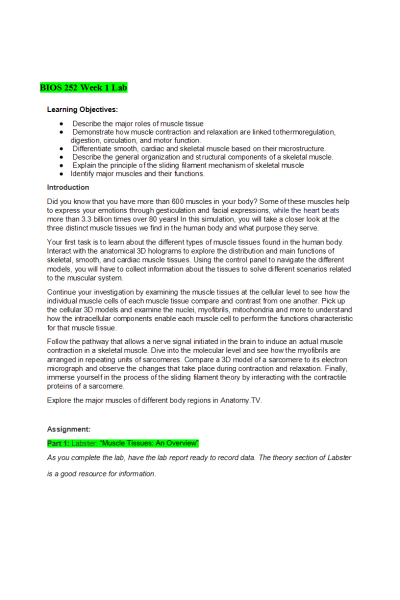BIOS 252 Week 1 Muscular System - Lab
-
$15.00
| Institution | BIOS 252 Anatomy and Physiology II wi/Lb |
| Contributor | Steve Sanders |
BIOS 252 Week 1 Lab
Learning Objectives:
- Describe the major roles of muscle tissue
- Demonstrate how muscle contraction and relaxation are linked to thermoregulation, digestion, circulation, and motor function.
- Differentiate smooth, cardiac and skeletal muscle based on their microstructure.
- Describe the general organization and structural components of a skeletal muscle.
- Explain the principle of the sliding filament mechanism of skeletal muscle
- Identify major muscles and their functions.
Introduction
Did you know that you have more than 600 muscles in your body? Some of these muscles help to express your emotions through gesticulation and facial expressions, while the heart beats more than 3.3 billion times over 80 years! In this simulation, you will take a closer look at the three distinct muscle tissues we find in the human body and what purpose they serve.
Your first task is to learn about the different types of muscle tissues found in the human body. Interact with the anatomical 3D holograms to explore the distribution and main functions of skeletal, smooth, and cardiac muscle tissues. Using the control panel to navigate the different models, you will have to collect information about the tissues to solve different scenarios related to the muscular system.
Continue your investigation by examining the muscle tissues at the cellular level to see how the individual muscle cells of each muscle tissue compare and contrast from one another. Pick up the cellular 3D models and examine the nuclei, myofibrils, mitochondria and more to understand how the intracellular components enable each muscle cell to perform the functions characteristic for that muscle tissue.
Follow the pathway that allows a nerve signal initiated in the brain to induce an actual muscle contraction in a skeletal muscle. Dive into the molecular level and see how the myofibrils are arranged in repeating units of sarcomeres. Compare a 3D model of a sarcomere to its electron micrograph and observe the changes that take place during contraction and relaxation. Finally, immerse yourself in the process of the sliding filament theory by interacting with the contractile proteins of a sarcomere.
Explore the major muscles of different body regions in Anatomy.TV.
Assignment:
Part 1: Labster: “Muscle Tissues: An Overview”
Part 2: Complete the following activities in Anatomy.TV
Part 3: Complete the lab report.
Muscular System Lab Report
- Labster
- Describe the different muscles tissues using the table: (4 points)
- What is a sarcomere? (½ point)
- a. Which contractile protein makes up the thick filament? (½ point)
b. Which contractile protein makes up the thin filament? (½ point)
- What ion binds to troponin and causes a conformational shape change to occur, moving the troponin away from the myosin head-binding sites? (½ point)
- In the following image of a relaxed sarcomere, identify: (1 ½ points total; ½ point each)
- Describe what is occurring at each of the 5 steps below. (2 1/2 points; 1/2 point each step)
Anatomy.TV
- a. Identify muscles B and J in the head image and identify their functions: (½ point each; 2 points total)
- Identify these muscles that acting together flex the neck, and acting individually draw the head to the same side shoulder? (½ point)
- Identify the large bulk of muscle that lays in the groove on either side of the entire vertebral column. It extends, laterally flexes, and rotates the vertebral column and is divided into 3 main sections (iliocostalis, longissimus, and spinalis). (½ point)
- Besides flexion and rotation of the trunk, identify 2 other roles that the abdominal muscles play? (1 point)
- A tear of the calcaneal/Achilles tendon would lead to difficulty with what motion at the ankle? (1 point)
| Instituition / Term | |
| Term | Summer Session |
| Institution | BIOS 252 Anatomy and Physiology II wi/Lb |
| Contributor | Steve Sanders |


























